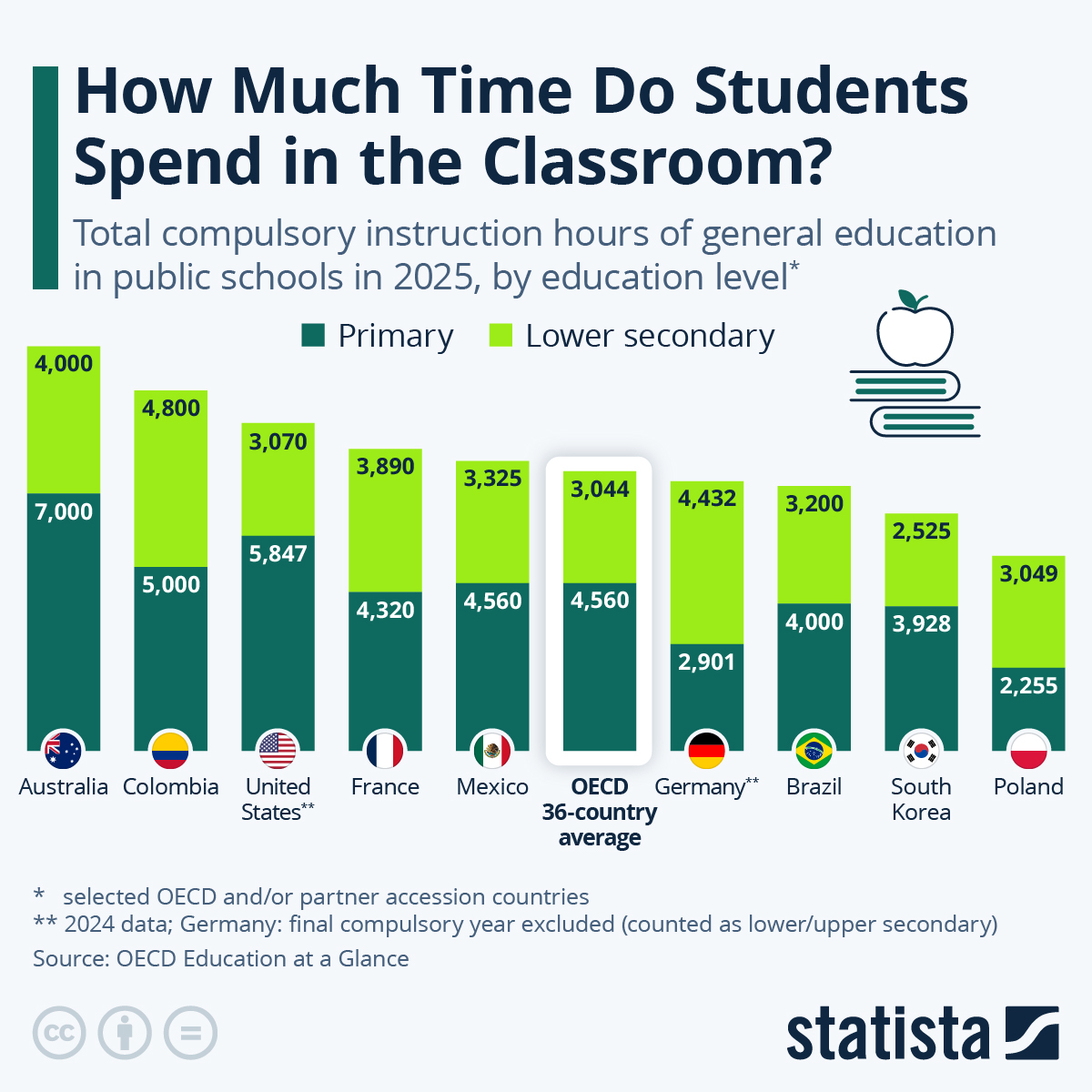See other World News Articles
Title: Aussie Students Spend The Most Time In School, Polish Kids The Least
Source:
[None]
URL Source: https://www.zerohedge.com/political ... -time-school-polish-kids-least
Published: Sep 12, 2025
Author: Tyler Durden
Post Date: 2025-09-12 11:08:16 by Horse
Keywords: None
Views: 1311
Comments: 4
Students in OECD countries and economies receive an average of 7,604 hours of compulsory instruction during their primary and lower secondary education. However, as Statista's Anna Fleck shows in the chart below, a wide gap exists between countries, with students in Poland receiving an average of just 5,304 hours, compared to Australia where children must attend nearly double that at 11,000 hours. In the United States, children spend 8,917 hours on average in compulsory classes across primary school and early secondary school. This is according to a new report by the OECD titled Education at a Glance. Primary education lasts six years on average across OECD countries and economies, ranging from four grades in Poland to seven in Australia and Denmark. In the U.S., children have six school years at the primary level. Lower secondary education lasts three years on average across the OECD member states, ranging from two years in the French Community of Belgium to six years in Lithuania. Poster Comment: Like to see those kids pass a test. I saw a documentary once of an American reporter who went to the best academic school in his area and did the same in Germany. (This was before Merkel ruined Germany with all the illegal aliens.) Then he asked to interview one student in the vocational training department, not a kid studying to get into university. In America he interviewed a Black kid who was flipping burgers at McDonalds. The school the Black kid was being prepared to enter the work force. In Germany the German kid was preparing to become a machinist. The class had $5 million (20 years ago) in machine tools donated by BMW. The kid hated school, but he was taking calculus, physics, computer programming and sufficient English to be fluent enough for an interview. On that day the teacher had put a bug in his numerical machine tool which he had to find and correct so he could get his machine running. American academic students could not have done what that voc ed student in Germany did. 
Post Comment Private Reply Ignore Thread
Top • Page Up • Full Thread • Page Down • Bottom/Latest
#1. To: Horse (#0)
so, all those polack jokes were based in truth it would seem.
Time in class doesn't necessarily equate to education quality.
I completely agree with you; much depends on the subject and the abilities of the teacher. I worked with a guy who could lecture on tying shoelaces and not be able to perform the operation. When I was young the river bottoms and the upland forests were my classrooms.
Absolutely. I rented a house from a university professor, and the rear glass sliding door of the house was difficult to open. When I reported this, the wife went and got a bottle of brake fluid to pour onto the lower track as the solution. They had no idea there were wheels on the door. I got them to repair the door properly. The husband was no doubt loaded with academic knowledge but had about zero real world problem solving / cognitive experience.
#2. To: ghostrider (#1)
so, all those polack jokes were based in truth it would seem.
#3. To: Pinguinite (#2)
#4. To: ghostrider (#3)
I worked with a guy who could lecture on tying shoelaces and not be able to perform the operation.
Top • Page Up • Full Thread • Page Down • Bottom/Latest